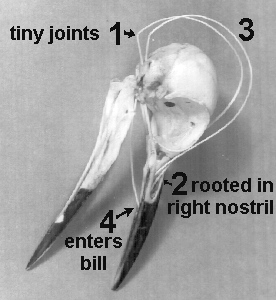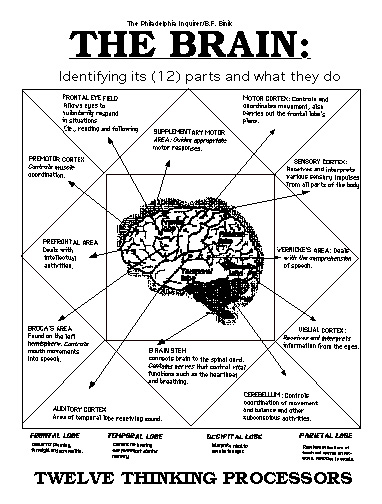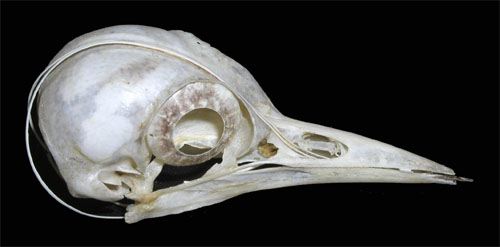A
Asyncritus
Guest
I watched, totally gobsmacked, at the program Wonders of Nature screened tonight.
It was about the marvellous little bird: the woodpecker.
The woodpecker bores into wood, to a depth of about 4 inches, to find its insect prey. It can apparently hear the grubs scrunching away in there, and sets about getting them by boring up to 4 inches in solid wood.
In order to do this, it bangs its beak into the wood, with a force of about 19 G's, and somehow, just somehow, manages to avoid beating its brains into mush from the ferocity and frequency of the impacts.
If a motorcyclist banged his head even once against a solid plank with that amount of force, he would smash his skull into little pieces, and die immediately.
The woodpecker survives, and lives to drill another day.
The scientists, needless to say, are fascinated by this bird's skull, and the way it is able to absorb the impacts on the wood.
If crash helmets, for example, could absorb the impacts as well as the woodpecker's skull does, then a huge number of lives would not be lost in collisions.
So they set about copying the design of the woodpecker skull.
"
Slow-motion footage, X-ray images and computer simulations have shed light on how woodpeckers avoid injuries to their brains as they peck.
Their heads move some 6m/s (20ft/s), at each peck enduring a deceleration more than 1,000 times that of gravity.
But researchers reporting in Plos One say that unequal upper and lower beak lengths and spongy, plate-like bone structure protect the birds' brains....
The birds have little "sub-dural space" between their brains and their skulls, so the brain does not have room to bump around as it does in humans. Also, their brains are longer top-to-bottom than front-to-back, meaning the force against the skull is spread over a larger brain area.
A highly-developed bone called the hyoid - which in humans is just above the "Adam's apple" - has also been studied: starting at the underside of the birds' beaks, it makes a full loop through their nostrils, under and around the back of their skulls, over the top and meeting again before the forehead.
[...]
The team's simulations showed that three factors were at work in sparing the birds injury.
Firstly, the hyoid bone's looping structure around the whole skull was found to act as a "safety belt", especially after the initial impact.
The team also found that the upper and lower halves of the birds' beaks were uneven, and as force was transmitted from the tip of the beak into the bone, this asymmetry lowered the load that made it as far as the brain.
Lastly, plate-like bones with a "spongy" structure at different points in the skull helped distribute the incoming force, thereby protecting the brain.
The team stresses that it is the combination of the three, rather than any one feature, that keeps woodpeckers pecking without injury." http://www.bbc.co.uk/news/science-environment-15458633

[SIZE=+2]A woodpecker's skull (to the right)[/SIZE]
[SIZE=+2]showing the bones of the tongue[/SIZE]
[FONT=Arial,Helvetica][SIZE=+1]There are five bones, thin and flexible with tiny joints.1 What made them exit through the right nostril and attach their sheath there, 2 circle behind the head and neck 3, and come back into the hollow between the two halves of the beak? 4[/SIZE][/FONT]
Dr. Sunderland, the owner of the skull in the picture, writes, "The woodpecker's skull has been more effective in convincing scientists of the inadequacies of the evolution theory than perhaps any book in the author's library.
Other birds have hyoid bones also, but it would seem obvious that some sort of miracle would be needed to get them rooted in the right nostril.
One prominent evolutionist on the staff of a prestigious scientific magazine confided after examining it 'There are certain anatomical features which just cannot be explained by gradual mutations over millions of years. Just between you and me, I have to get God into the act too sometimes.'"http://www.creationism.org/heinze/Woodpecker.htm
The hopeless talkorigins writer on the subject, is a little rusty in logic.
He has failed utterly, to address the real problems, which the producer of the Wonders of Nature program mentioned above illustrated beautifully.
This is what I mean.
One scientist designed a structure copying the arrangement of the 4 layers of bone in the woodpecker's skull.
They put an ordinary light bulb in the structure, protected from shock in the same way that the woodpecker's brain is protected in its skull, and then, attached the structure to a helium balloon.
The helium-filled balloon was released, and floated up to a height of 85,000 feet, when the structure containing the light bulb was released and fell to earth for about 15 minutes.
It reached a velocity exceeding the speed of sound, and crashed into a rock canyon several miles away from the intended target area, because of winds.
The capsule was found and opened on camera, and to everybody's surprise, the light bulb was intact, and the bulb still functioned.
To say I was gobsmacked is understating the case considerably.
But it is obvious that such an extraordinarily effective protecting device is needed to protect the woodpecker's brain from being pounded into mush.
It is equally obvious that those species of woodpecker with that protection could not have evolved by that foolishly bleated combination of mutations and natural selection!
If the first such proto-woodpecker had no such protection, then its first effort to drill into solid wood would have ended in failure and concussion!
And he would have gone and found some easier way to make a living.
But no. Here they all are, drilling away happily in wood, to the discomfiture of the grubs they catch, and the embarrassment of the OOOHHHH--MMMM---Natural selecti--oo--nnn and mu----ta----tionnn brigade.
And the wonderfully intelligent design of their skulls may yet be copied by intelligent mankind, and save the lives of many, including the evolutionist motorcyclists.
Some idiot will doubtless point to other similar birds, wave a magic wand and say, why, here's a few simpler kinds of woodpecker. They must have evolved somehow into this marvellously intricate little bird.
We know better, don't we.
It took a brain to design the system. It took brains to copy the system. Chance has no place here.
I may also point out the fact that all the equipment necessary to find and drill for insects, is entirely useless without the powering instincts required to employ the tools.
No-one in their right senses would dream of putting a pneumatic chisel in the hands of an untrained person, and say 'Here you are, find that insect under the pavement. Then stick your tongue into the hole, and bring it out!'
No, training and information about the use of the chisel is essential to success in its use.
Similarly here. The instincts necessary to the use of the ears of the bird, its beak, its tail, its claws and legs which support it on the tree trunk, its marvellous tongue, had to be implanted in completeness by the Creator. Else, the species would have perished before it started!
Go here for a fascinating account of the structure of the woodpecker's tongue!
http://www.hiltonpond.org/thisweek030308.html
It was about the marvellous little bird: the woodpecker.
The woodpecker bores into wood, to a depth of about 4 inches, to find its insect prey. It can apparently hear the grubs scrunching away in there, and sets about getting them by boring up to 4 inches in solid wood.
In order to do this, it bangs its beak into the wood, with a force of about 19 G's, and somehow, just somehow, manages to avoid beating its brains into mush from the ferocity and frequency of the impacts.
If a motorcyclist banged his head even once against a solid plank with that amount of force, he would smash his skull into little pieces, and die immediately.
The woodpecker survives, and lives to drill another day.
The scientists, needless to say, are fascinated by this bird's skull, and the way it is able to absorb the impacts on the wood.
If crash helmets, for example, could absorb the impacts as well as the woodpecker's skull does, then a huge number of lives would not be lost in collisions.
So they set about copying the design of the woodpecker skull.
"
Slow-motion footage, X-ray images and computer simulations have shed light on how woodpeckers avoid injuries to their brains as they peck.
Their heads move some 6m/s (20ft/s), at each peck enduring a deceleration more than 1,000 times that of gravity.
But researchers reporting in Plos One say that unequal upper and lower beak lengths and spongy, plate-like bone structure protect the birds' brains....
The birds have little "sub-dural space" between their brains and their skulls, so the brain does not have room to bump around as it does in humans. Also, their brains are longer top-to-bottom than front-to-back, meaning the force against the skull is spread over a larger brain area.
A highly-developed bone called the hyoid - which in humans is just above the "Adam's apple" - has also been studied: starting at the underside of the birds' beaks, it makes a full loop through their nostrils, under and around the back of their skulls, over the top and meeting again before the forehead.
[...]
The team's simulations showed that three factors were at work in sparing the birds injury.
Firstly, the hyoid bone's looping structure around the whole skull was found to act as a "safety belt", especially after the initial impact.
The team also found that the upper and lower halves of the birds' beaks were uneven, and as force was transmitted from the tip of the beak into the bone, this asymmetry lowered the load that made it as far as the brain.
Lastly, plate-like bones with a "spongy" structure at different points in the skull helped distribute the incoming force, thereby protecting the brain.
The team stresses that it is the combination of the three, rather than any one feature, that keeps woodpeckers pecking without injury." http://www.bbc.co.uk/news/science-environment-15458633

[SIZE=+2]showing the bones of the tongue[/SIZE]
[FONT=Arial,Helvetica][SIZE=+1]There are five bones, thin and flexible with tiny joints.1 What made them exit through the right nostril and attach their sheath there, 2 circle behind the head and neck 3, and come back into the hollow between the two halves of the beak? 4[/SIZE][/FONT]
Dr. Sunderland, the owner of the skull in the picture, writes, "The woodpecker's skull has been more effective in convincing scientists of the inadequacies of the evolution theory than perhaps any book in the author's library.
Other birds have hyoid bones also, but it would seem obvious that some sort of miracle would be needed to get them rooted in the right nostril.
One prominent evolutionist on the staff of a prestigious scientific magazine confided after examining it 'There are certain anatomical features which just cannot be explained by gradual mutations over millions of years. Just between you and me, I have to get God into the act too sometimes.'"http://www.creationism.org/heinze/Woodpecker.htm
The hopeless talkorigins writer on the subject, is a little rusty in logic.
He has failed utterly, to address the real problems, which the producer of the Wonders of Nature program mentioned above illustrated beautifully.
This is what I mean.
One scientist designed a structure copying the arrangement of the 4 layers of bone in the woodpecker's skull.
They put an ordinary light bulb in the structure, protected from shock in the same way that the woodpecker's brain is protected in its skull, and then, attached the structure to a helium balloon.
The helium-filled balloon was released, and floated up to a height of 85,000 feet, when the structure containing the light bulb was released and fell to earth for about 15 minutes.
It reached a velocity exceeding the speed of sound, and crashed into a rock canyon several miles away from the intended target area, because of winds.
The capsule was found and opened on camera, and to everybody's surprise, the light bulb was intact, and the bulb still functioned.
To say I was gobsmacked is understating the case considerably.
But it is obvious that such an extraordinarily effective protecting device is needed to protect the woodpecker's brain from being pounded into mush.
It is equally obvious that those species of woodpecker with that protection could not have evolved by that foolishly bleated combination of mutations and natural selection!
If the first such proto-woodpecker had no such protection, then its first effort to drill into solid wood would have ended in failure and concussion!
And he would have gone and found some easier way to make a living.
But no. Here they all are, drilling away happily in wood, to the discomfiture of the grubs they catch, and the embarrassment of the OOOHHHH--MMMM---Natural selecti--oo--nnn and mu----ta----tionnn brigade.
And the wonderfully intelligent design of their skulls may yet be copied by intelligent mankind, and save the lives of many, including the evolutionist motorcyclists.
Some idiot will doubtless point to other similar birds, wave a magic wand and say, why, here's a few simpler kinds of woodpecker. They must have evolved somehow into this marvellously intricate little bird.
We know better, don't we.
It took a brain to design the system. It took brains to copy the system. Chance has no place here.
I may also point out the fact that all the equipment necessary to find and drill for insects, is entirely useless without the powering instincts required to employ the tools.
No-one in their right senses would dream of putting a pneumatic chisel in the hands of an untrained person, and say 'Here you are, find that insect under the pavement. Then stick your tongue into the hole, and bring it out!'
No, training and information about the use of the chisel is essential to success in its use.
Similarly here. The instincts necessary to the use of the ears of the bird, its beak, its tail, its claws and legs which support it on the tree trunk, its marvellous tongue, had to be implanted in completeness by the Creator. Else, the species would have perished before it started!
Go here for a fascinating account of the structure of the woodpecker's tongue!
http://www.hiltonpond.org/thisweek030308.html
Last edited by a moderator:











